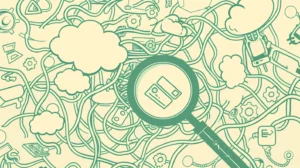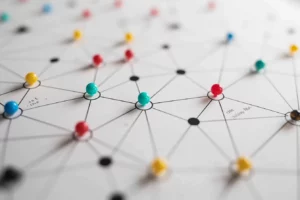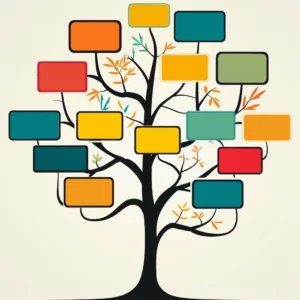Have you ever thought about how you understand new topics? Our brain requires us to make a connection to other topics to learn new information. Reading comprehension is not just about understanding individual words on a page. It’s about learning the larger concepts, themes, and connections within a text.
One powerful tool to improve reading comprehension is the use of mind maps. Mind maps have visual and hierarchical structure. They are an effective way to organize information, create schemas, and deepen understanding. Let’s explore how you can use mind maps to boost your reading comprehension through schema building.

What is Schema?
Schema sounds like a complex word doesn’t it? But it is easy to understand. Schema, in simple terms, is like a mental folder in your brain. It’s a way your brain organizes information into categories or frameworks based on past experiences and knowledge.
When you encounter new information, your brain tries to fit it into these existing mental folders. This helps you understand and remember things better because you can link new information to what you already know. For example, if you see a new Audi, your brain might put it in the “Cars” folder. It will connect the new Audi to the existing cars you know. Schema helps your brain make sense of the world by grouping similar things together.
The Role of Mind Maps in Schema Building
Have you noticed how you learn better with structures and colorful information? Mind Maps are the technique to rely on for that. Mind Maps help you organize ideas visually. They’re like pictures of how things connect. When you make a mind map, you’re making a map of your thoughts.
The main idea is like the big folder, and the branches are smaller folders. These folders show how ideas are related. When you add more details, it helps you remember better. So, when you look at the map later, it reminds you of what you learned. Mind maps are like helpful pictures that make it easier to understand and remember things. They’re great tools for building a clear picture of how ideas fit together in your brain.

Steps to Using Mind Maps for Schema Building and Reading Comprehension
Mind Maps are creative and organized too to improve schema extracting. They also improve reading comprehension through schema extraction. Here are the steps to use Mind Maps for schema extraction and improved reading comprehension.
Prepare Before Reading to extract Schema
Before you start reading, make a simple mind map:
- Think About What You Know: Write down what you already know about the topic.
- Key Terms: List important words related to the topic.
- Questions: Note down any questions you have about the topic.
This helps your brain get ready to make connections with the new information you will read. For example, if you’re reading about the Water Cycle, your map could include rain, climate change and location. When you start reading, your mind is already primed to link new facts to these key points helping in schema.
Schema Extraction through Active Reading with Mind Maps
When you’re reading, have your mind map nearby:
- Add New Ideas: Whenever you find something new, write it on your map as a new branch.
- Include Key Points: Jot down important points or facts related to the new idea.
- Definitions and Examples: If there’s a new word or concept, add its definition and examples.
This active way of reading helps you connect the dots between different ideas. For instance, if you’re learning about Photosynthesis, you might add Sunlight, Carbon Dioxide, and Oxygen as branches. As you read more, you’ll see how these ideas are linked and remember them better through schema extraction.
Connecting Ideas for Schema
When you’re adding ideas to your mind map, think about how they connect:
- Use Lines: Draw lines to connect related ideas. This shows how they’re linked.
- Colors and Symbols: Use colors or symbols to show different kinds of connections.
- Types of Relationships: Think about cause and effect, comparisons, or contrasts.
For example, if you’re studying Weather Patterns, you might connect Rain to Clouds with a line. This shows that rain comes from clouds. You could use a blue color for rain and a white cloud symbol to make it clear. These visual connections make it easier to remember and understand the relationships between ideas. Your brain connects one detail to another helping in schema extraction.

Summarize and Synthesize for Schema
When you’re done reading, go back to your mind map:
- Review Your Map: Take a look at all the branches and connections you’ve made.
- Summarize Main Points: Use your map to summarize what you’ve learned. Write down the key ideas.
- Find Patterns: Look for any patterns or relationships between the ideas on your map.
For example, if you’re studying World War II, your map might have branches like Causes, Key Battles, and Effects. Summarize each section briefly. You might see a pattern where certain events led to others, or how battles influenced the outcome. This visual summary helps in schema extraction of what you’ve learned and makes it easier to remember for later.
Exam Preparation With Your Mind Map
When you’re getting ready for a test or exam, your mind map is your study buddy:
Study Tool: Your mind map is a valuable resource for studying.
Quick Review: Instead of reading all your notes, look at your mind map. It has the key points.
Refresh Your Memory: Reviewing your map helps you remember the main ideas quickly.
For example, if your exam is on “Cell Biology,” your mind map might have branches for “Cell Parts,” “Functions,” and “Cell Division.” Instead of reading all your notes on each topic, just look at your map. You’ll see the main points and connections. This focused review helps you refresh your memory and understand the material better as a whole.
Repeat and Expand Your Mind Map for Improving Schema
Mind maps are not set in stone; they grow with your learning:
- Revisit and Revise: Go back to your map regularly. Add new branches or revise existing ones.
- Dynamic Tools: Your mind map can change and expand as you learn more.
- Deepen Understanding: This process helps you understand the topic better over time.
For example, if you’re learning about Ancient Civilizations, you might start with branches for Egypt and China. As you learn more about each civilization, add new branches with details like Pyramids under Egypt or Inventions under China. Your map grows richer and more detailed with each new piece of information. This active engagement with your mind map helps deepen your understanding and allows your schema to evolve with your learning journey.

Tips for Effective Mind Mapping and Schema Building
When creating mind maps for better understanding and reading comprehension, consider these simple yet powerful tips.
- Color-code for Clarity
- Visual Cues: Assign different colors to different branches or categories.
- Easy Identification: Colors help you quickly see which ideas are related.
- Example: Use green for Effects of Poverty, and red for Causes.
- Create Hierarchies
- Main and Sub-Branches: Start with the main topic in the center, then add sub-branches.
- Organized Structure: This hierarchical structure helps you see the big picture.
- Example: Under Poverty have branches for Causes, Effects and Solutions.
- Use Visuals
- Add Images: Include simple drawings, symbols, or icons.
- Improve Memory: Visuals make your mind map more engaging and easier to remember.
- Example: Draw a group of stick figures for population under causes of poverty.
- Review Regularly
- Keep It Fresh: Periodically revisit your mind map to reinforce what you’ve learned.
- Update as Needed: Add new information or revise existing branches.
- Example: Every week, take a few minutes to review and update your mind map with new facts.

Why These Tips Work
- Brain-friendly: Short phrases and colors are easier for your brain to process.
- Visual Memory: Images and symbols help you remember information better.
- Organization: Hierarchies and categories make complex topics more manageable.
Practical Example: Mind Map on Poverty
Let’s create a mind map about “Poverty” using the same tips:
- Central Topic: Write “Poverty” in the center of your page.
- Color-coding: Use red for “Causes,” blue for “Effects,” and green for “Solutions.”
- Hierarchies: Under “Causes,” have branches for “Unemployment,” “Lack of Education,” and “Inequality.”
- Visuals: Draw a broken chain for “Unemployment,” a book for “Lack of Education,” and a scale for “Inequality.”
- Conciseness: Instead of long explanations, use short phrases like “Limited Opportunities” under “Unemployment” and “Cycle of Poverty” under “Inequality.”
This mind map is now a clear and organized visual representation of the topic. When you review it later, the colors, images, and concise phrases will help you remember the key points.
Conclusion
By using mind maps for schema building, you can improve your reading comprehension. Mind maps are great for understanding. They’re like organized pictures of thoughts. They connect ideas visually, helping you remember better. Whether you’re a student, a pro, or just curious, mind maps help. They boost memory, build connections, and improve thinking skills. Next time you read something tough, try a mind map. Use pen and paper or an app. Your brain will love the clear, organized help from mind maps. Your brain will thank you for it



